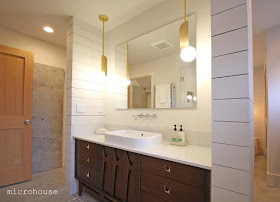eastlake backyard cottage
How did the idea of building a backyard cottage come about?
Colette: My husband Chris and I moved back to Seattle in 2010 with our two children and were able to buy my childhood home from my family. The home needed extensive work so we did it at a very slow pace. Once the main house was close to being finished we noticed that many houses on our block were being sold to developers. What was once a quiet Craftsman lined street was turning into rows of apartment buildings.
That got us thinking about how to preserve my childhood home and invest and grow with the neighborhood. It was simple: build a backyard cottage and use it as a short-term rental to pay off the new debt, and later have a guest house. We also began to see it as a great investment into our retirement and something we can leave to our kids. We can live in the cottage when the kids are gone, or perhaps we can fly off to Italy and let the cottage and house support us in our next stage of life. The cottage suddenly gave us positive options for the future.
entry looking towards the kitchen
What did you enjoy most about the process?
Colette: I loved every part of the process. Because our lot was small and there were only a certain number of ways to build our structure, the design part became quite easy. Bruce and Stefan [of microhouse] were great at listening to what we wanted and were always willing to change things to get them right.
At one point in the build we had some large joists delivered that were used as our entryway ceiling and our loft floor. Garrick, our builder, set them up for me and loaned me his sander so I could work on them before they were installed. I really enjoyed that they allowed me access to work on projects for the cottage.
I was also able to design the inside of the cottage to fit furniture I was buying along the way. Walls were made to fit vanities and all the lighting was installed to my specifications for the fixtures I had bought.
I was also able to design the inside of the cottage to fit furniture I was buying along the way. Walls were made to fit vanities and all the lighting was installed to my specifications for the fixtures I had bought.
living room looking towards the entry
What challenges did you face during the process?
Colette: My biggest challenge in this process was my neighbor. They didn’t like what we were doing. They objected to noise, dust, and anything that needed to go over their property line. It became quite ugly and it was a sad break to a 30-year friendship.
For me, living through construction was pretty fun. It was great to look out the kitchen window and watch walls go up. Garrick and I became friends and it was easy to have him around. He was missed when the project ended.
For me, living through construction was pretty fun. It was great to look out the kitchen window and watch walls go up. Garrick and I became friends and it was easy to have him around. He was missed when the project ended.
How long did the process take?
Colette: It took about a year to get the plans down just right. The build began just before fall of 2017 and ended in the spring of 2018.
the master bedroom opens up onto a private patio
master bedroom on lower floor, bath beyond
master bath beyond
Is there anything you would do differently if you had to do it over?
Colette: If we ever decide to build again I would work with Bruce, Stefan and Garrick again. It was truly a pleasure.
2nd bedroom located on the 3rd floor
What’s your favorite thing about your cottage?
Colette: I love the size of our cottage. It looks narrow and small from the outside, but when you enter it seems much, much larger. It feels like a trick of the eye. I love the shiplap wall we built as a focal point. I love that the appliances all fit into the kitchen I assembled. I love that I was very much a part of the build and that my ideas and creativity were used throughout.
a full bath located off of the entry











